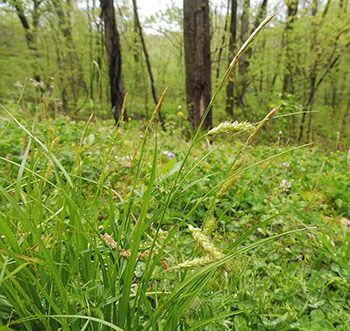Cherokee Sedge

Carex cherokeensis
Family: Cyperaceae (Sedge Family)
Cherokee Sedge (Carex cherokeensis) is a versatile, low-maintenance native sedge found in Texas, including Southeast Texas. This attractive, grass-like perennial is excellent for ground cover, erosion control, and habitat restoration. Its adaptability to both sun and shade makes it a valuable addition to native gardens and sustainable landscapes.
- Scientific Name: Carex cherokeensis
- Common Names: Cherokee Sedge
- Family: Cyperaceae (Sedge Family)
- Growth Habit: Clumping perennial
- Height: 1-2 feet
- Leaves: Narrow, arching, dark green
- Flowers: Small, inconspicuous spikes
- Bloom Time: Spring to early summer
- Wildlife Benefits: Provides cover for small wildlife and seeds for birds
Habitat & Range in Southeast Texas
Cherokee Sedge is commonly found in:
- Moist Woodlands: Thrives under tree canopies
- Riparian Areas: Grows along streambanks and wetlands
- Prairies & Meadows: Found in well-drained soils with periodic moisture
This adaptable species can handle a variety of soil types, from moist loam to drier sandy conditions.
Ecological Importance
- Erosion Control: Helps stabilize soil in wet and dry areas.
- Pollinator Support: While not a primary nectar source, it contributes to overall ecosystem diversity.
- Wildlife Habitat: Provides shelter and food for insects and birds.
Landscaping & Gardening Uses
Cherokee Sedge is a great native alternative to non-native turf grasses and is used for:
- Ground Cover: Fills in garden spaces with lush, low-maintenance greenery.
- Rain Gardens: Thrives in seasonal wet and dry conditions.
- Shade Gardens: Ideal for planting under trees where turf struggles.
Planting & Care
- Sunlight: Partial shade to full sun
- Soil: Prefers moist, well-drained soil but tolerates various conditions
- Water Needs: Moderate; drought-tolerant once established
- Maintenance: Low; occasional trimming to remove old foliage
- Companion Plants: Works well with Inland Sea Oats (Chasmanthium latifolium), Gulf Coast Penstemon (Penstemon tenuis), and Turk’s Cap (Malvaviscus arboreus var. drummondii)
Fun Facts
- As a native sedge, it requires less water and fertilizer than traditional turf grasses.
- Its deep roots improve soil health and water infiltration.
- It provides year-round interest with its fine-textured foliage.
Conservation & Native Plant Advocacy
Using Cherokee Sedge in landscapes supports local biodiversity and reduces reliance on resource-intensive non-native grasses. It is an essential component of native plant restoration efforts across Texas.
Where to Find It
-
Interested in adding Cherokee Sedge to your garden? Check if this is in stock or add to cart to purchase directly from our Natives Nursery.


